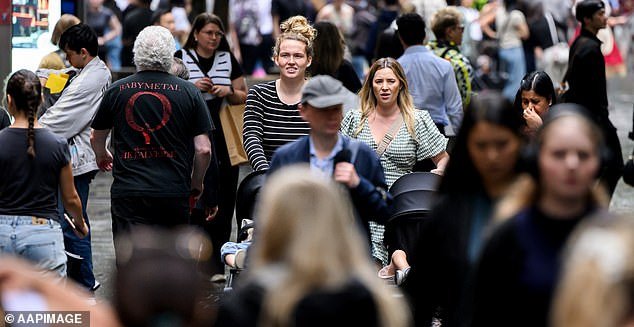With the Australian dollar now getting just 61 US cents – its lowest level in five years – consumer sentiment is falling and fears over what it means for mortgages are rising.
Other than three days in October 2022, the Aussie dollar has not been below 62 US cents since late March and early April of 2020 – the first time it had reached so low since during the global financial crisis in 2008.
This has sparked fears the falling Australian dollar will lead to higher prices on imports and mean the Reserve Bank of Australia (RBA) will be reluctant to cut rates, dashing hope of any relief from mortgage payments.
But Westpac chief economist Luci Ellis told Daily Mail Australia the situation is not that simple, there are much broader facts to consider and the short answer is no, the exchange rate is not that big a factor.
‘What’s really going on is the US dollar is strong,’ Ms Ellis said on Tuesday.
‘And the reason for that is that market participants have changed their minds about what they expect the Fed (US Federal Reserve) will do.
‘They’re now expecting that the Fed will not cut rates as much as they previously thought. And in fact one of the big global banks, Royal Bank of Canada, now say they don’t think the Fed will be cutting any further at all.
‘So if rates in the US are going to be higher, that makes US dollars denominated securities look more attractive… it’s not us, it’s them.’

With the Australian dollar now getting just 61 US cents – its lowest level in five years – fears for what it means for mortgages are rising (pictured, shoppers in Sydney)

Westpac chief economist Luci Ellis (pictured) told Daily Mail Australia there are much broader factors for the RBA to factor into any decision on an interest rate cut
Ms Ellis said it was ‘possible consumers were reacting to news about the depreciation of the Australian dollar against the US dollar, which resulted in some negative headlines about the outlook for interest rates and the broader economy’.
As well as a sharp decline from above 69 US cents in late September, consumer confidence around jobs also fell by 2.8 per cent to 127.2 per cent, despite the unemployment rate falling to 3.9 per cent in November.
‘Consumer confidence around jobs continues to deteriorate even though recent official data on unemployment has remained low and job vacancies have increased,’ the chief economist said.
In better news, though, Aussies are feeling more positive about the housing market.
While views on mortgage rates declined slightly, from 105.8 per cent to 105.7 per cent, expectations for the overall housing situation have improved.
‘Within the overall view on interest rates in January, homeowners with a mortgage were more likely to expect a rate cut than renters or outright owners,’ Ms Ellis said.
‘While the share of (mortgage holders) expecting a cut has exceeded that of renters for more than a year, the increase this month has put them ahead of owners as well.’
Ultimately, the current fall in the value of the Australian dollar against the greenback will have ‘a fairly small effect’ on any interest rate decision, Ms Ellis said.

Other than three days in October 2022, the Aussie has not been below 62 US cents since late March and early April of 2020 (Australian and US currency notes are pictured)
‘It’s not a major impact on what the RBA is going to decide,’ the economist said.
‘More important to what the RBA is going to decide is whether inflation is coming down quickly enough – we’ll know more about that later in the month – and whether the labor market is still easing.
‘So the RBA assesses the labor market as being kind of overtight, more than full employment, and so they’re looking to see more easing in the labor market and in the second half of last year just gone, we didn’t see that.
‘In fact, unemployment ticked down in November. We’ll know what happened in December on Thursday. Job vacancies picked up in November, so there’s reasons to think that the labor market wasn’t easing to the same extent, or possibly not easing at all in that second half of 2024.’
Ms Ellis said ‘if that’s the case, then the RBA is going to be worried that demand in Australia is still outstripping supply and therefore that would effect their outlook for inflation. The exchange rate is an input into that decision, but it’s a small one’.
The economist added there was a growing view that mortgage rate decreases are coming and a recognition that housing prices have slowed or even fallen in most population centres.
Australia’s big four banks are divided on when a rate cut will happen. ANZ and the Commonwealth Bank say the first rate cut could be in February.
But NAB and Westpac are more pessimistic and believe the first rate cut will not come until May.







